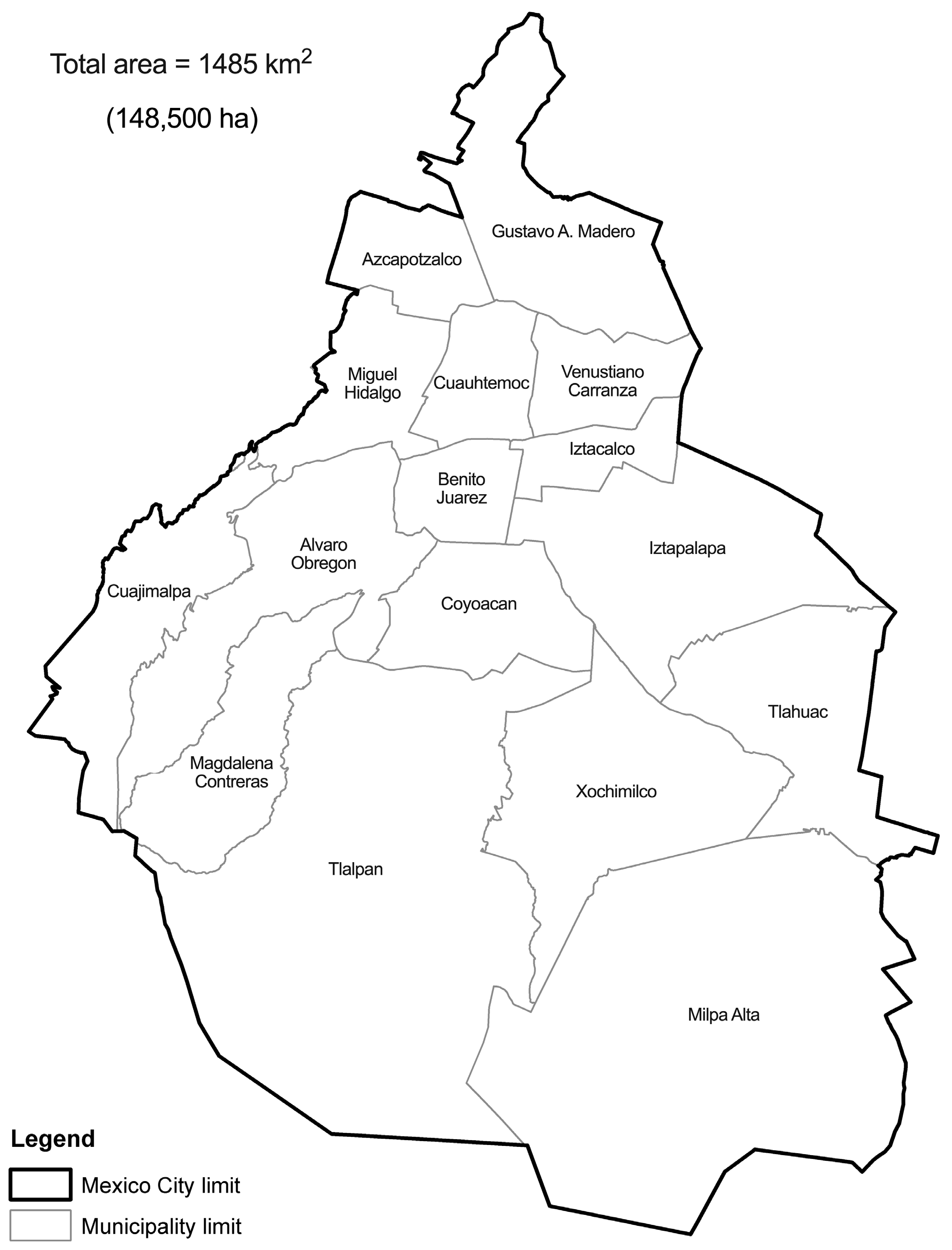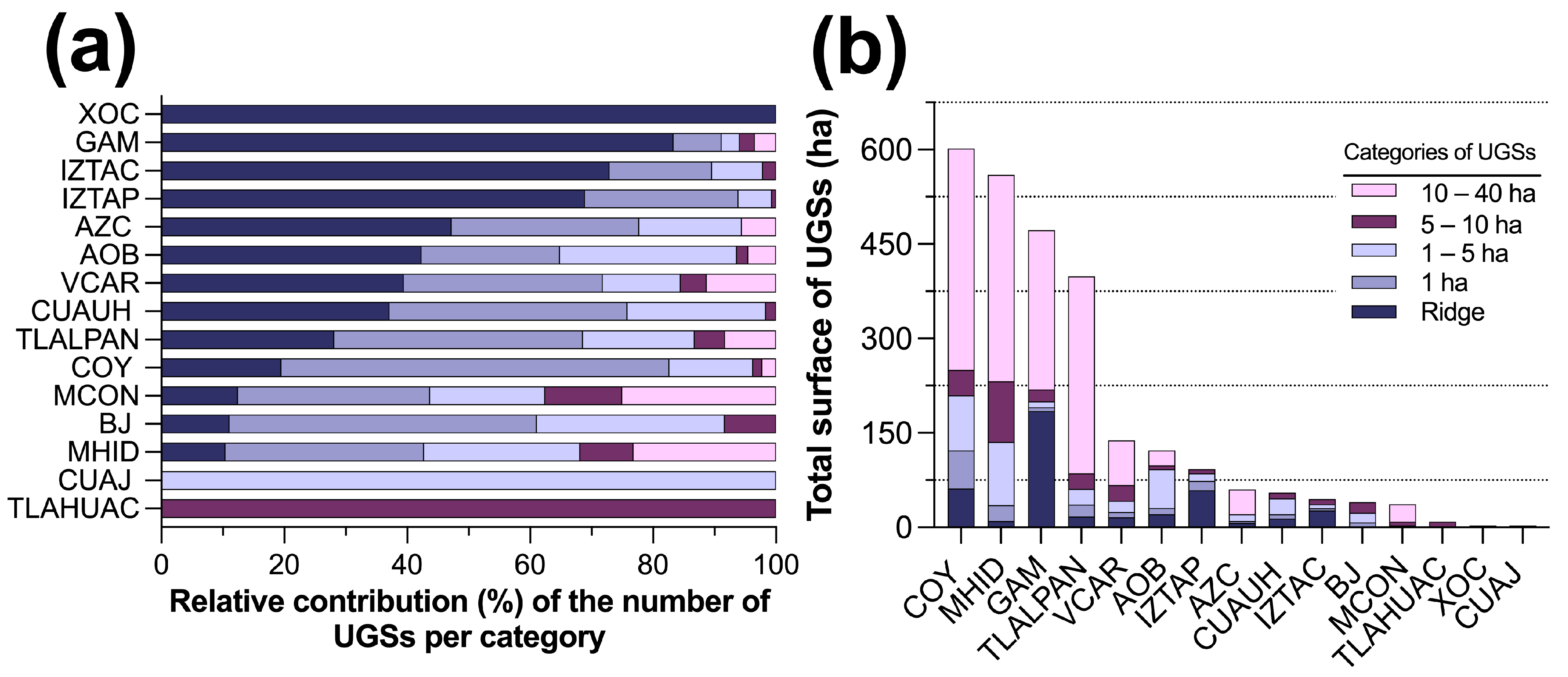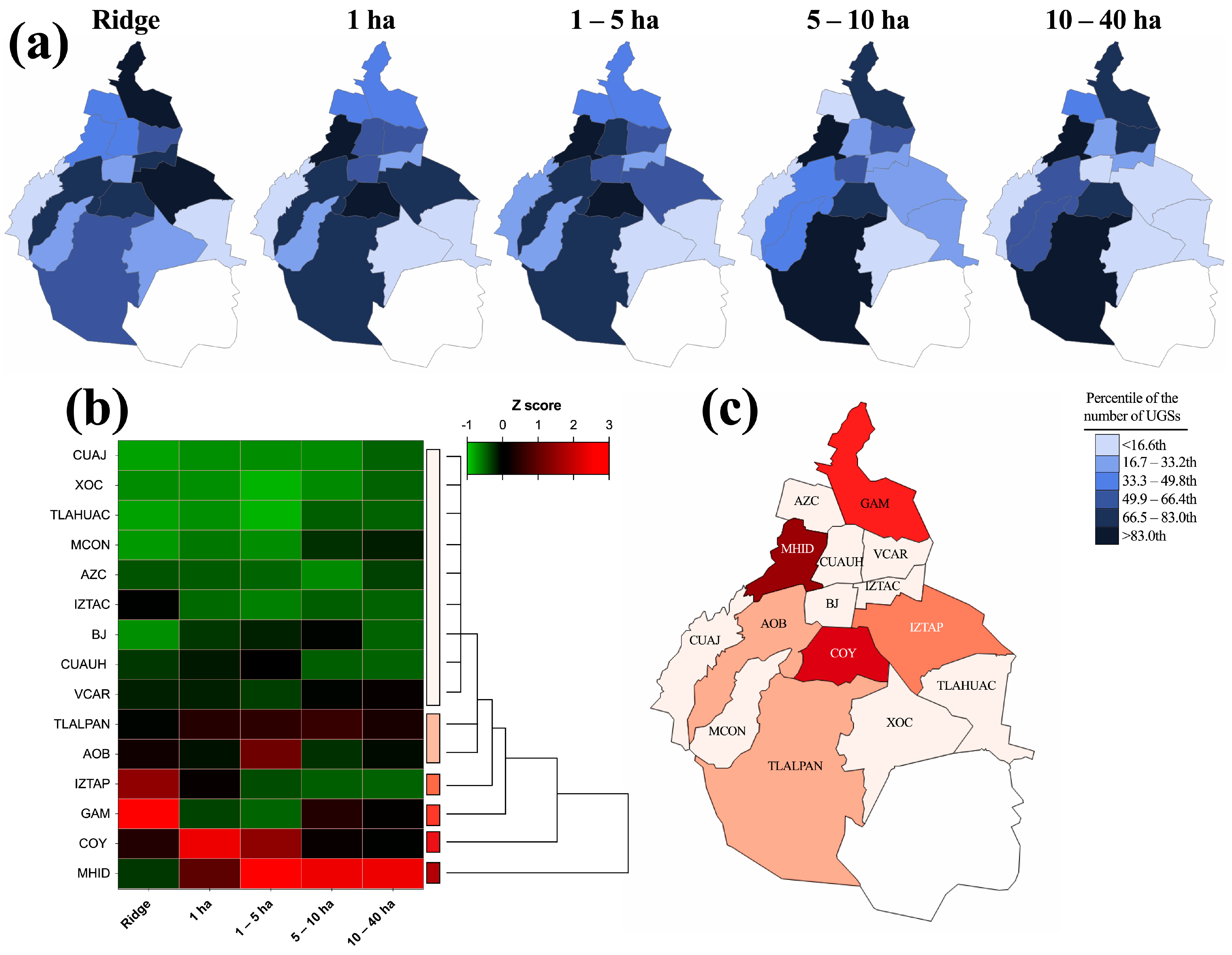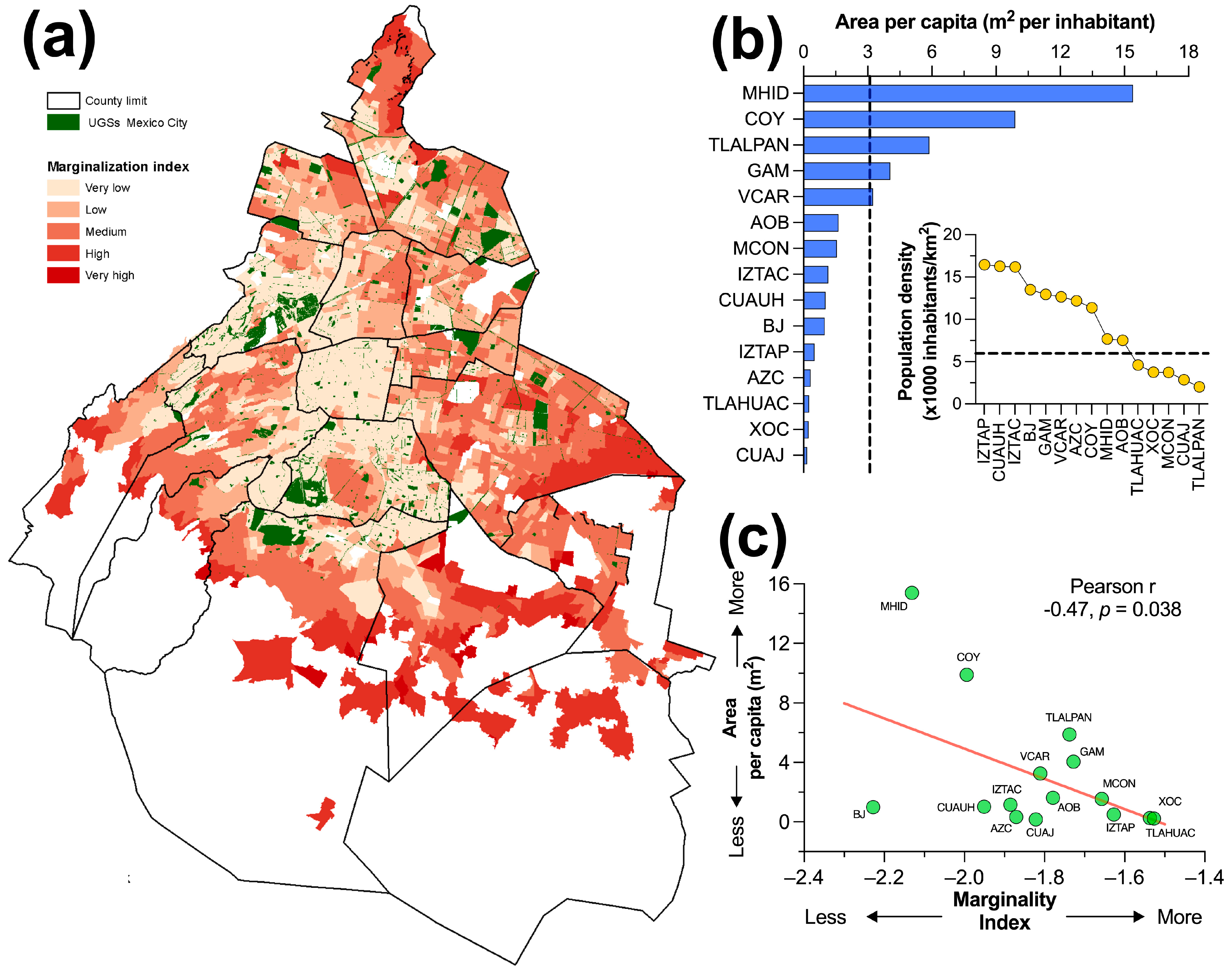Uneven Distribution of Urban Green Spaces in Relation to Marginalization in Mexico City
Abstract
1. Introduction
2. Materials and Methods
2.1. Study Site
2.2. Classification of Urban Green Spaces
2.3. Spatial Distribution, Size, and Number of Urban Green Spaces among Municipalities
2.4. Association of Urban Green Spaces and Socioeconomic Indicators
2.5. Statistical Analysis
3. Results
3.1. Number and Surface Area of Urban Green Spaces in the Municipalities of Mexico City
3.2. Composition of the Green Spaces among Municipalities of Mexico City
3.3. Spatial Distribution of UGSs across the Municipalities of Mexico City
3.4. Association between UGS Socioeconomic Indicators in Mexico City
4. Discussion
5. Conclusions
Author Contributions
Funding
Data Availability Statement
Acknowledgments
Conflicts of Interest
References
- Gruebner, O.; Rapp, M.A.; Adli, M.; Kluge, U.; Galea, S.; Heinz, A. Cities and mental health. Dtsch. Arztebl. Int. 2017, 114, 121–127. [Google Scholar] [CrossRef]
- Cox, D.T.C.; Hudson, H.L.; Shanahan, D.F.; Fuller, R.A.; Gaston, K.J. The rarity of direct experiences of nature in an urban population. Landsc. Urban Plan. 2017, 160, 79–84. [Google Scholar] [CrossRef]
- Cram, S.; Cotler, H.; Morales, L.M.; Sommer, I.; Carmona, E. Identificación de los servicios ambientales potenciales de los suelos en el paisaje urbano del Distrito Federal. Investig. Geogr. 2008, 66, 81–104. [Google Scholar]
- Coventry, P.A.; Neale, C.; Dyke, A.; Pateman, R.; Cinderby, S. The mental health benefits of purposeful activities in public green spaces in urban and semiurban neighborhoods: A mixed-methods pilot and proof of concept study. Int. J. Environ. Res. Public Health 2019, 16, 2712. [Google Scholar] [CrossRef]
- MacKerron, G.; Mourato, S. Happiness is greater in natural environments. Glob. Environ. Change 2013, 23, 992–1000. [Google Scholar] [CrossRef]
- Ramírez, P.C.; Camargo, D.M.; Quiroga, V.; Rios, A.P.; Fermino, R.C.; Sarmiento, O.L. Qualidade dos parques públicos urbanos para a prática de atividades físicas em Bucaramanga, Colômbia. Rev. Bras. Cineantropometria Desempenho Hum. 2017, 19, 480–492. [Google Scholar]
- Huynh, Q.; Craig, W.; Janssen, I.; Pickett, W. Exposure to public natural space as a protective factor for emotional well-being among young people in Canada. BMC Public Health 2013, 13, 407. [Google Scholar] [CrossRef]
- Giedych, R.; Maksymiuk, G. Specific features of parks and their impact on regulation and cultural ecosystem services provision in Warsaw, Poland. Sustainability 2017, 9, 792. [Google Scholar] [CrossRef]
- Li, W.; Saphores, J.; Gillespie, T.W. A comparison of the economic benefits of urban green spaces estimated with NDVI and with high-resolution land cover data. Landsc. Urban Plan. 2015, 133, 105–117. [Google Scholar] [CrossRef]
- Reyes-Riveros, R.; Altamirano, A.; De La Barrera, F.; Rozas-Vásquez, D.; Vieli, L.; Meli, P. Linking public urban green spaces and human well-being: A systematic review. Urban For. Urban Green. 2021, 61, 127105. [Google Scholar] [CrossRef]
- Ninan, K.N.; Inoue, M. Valuing forest ecosystem services: What we know and what we don’t. Ecol. Econ. 2013, 93, 137–149. [Google Scholar] [CrossRef]
- MacGregor-Fors, I.; Morales-Pérez, L.; Quesada, J.; Schondube, J.E. Relationship between the presence of House Sparrows (Passer domesticus) and Neotropical bird community structure and diversity. Biol. Invasions 2009, 12, 87–96. [Google Scholar] [CrossRef]
- Baró, F.; Calderón-Argelich, A.; Langemeyer, J.; Connolly, J.J.T. Under one canopy? Assessing the distributional environmental justice implications of street tree benefits in Barcelona. Environ. Sci. Policy 2019, 102, 54–64. [Google Scholar] [CrossRef]
- Tian, Y.; Jim, C.Y.; Liu, Y. Using a spatial interaction model to assess the accessibility of district parks in Hong Kong. Sustainability 2017, 9, 1924. [Google Scholar] [CrossRef]
- De Vries, S.; van Dillen, S.M.E.; Groenewegen, P.P.; Spreeuwenberg, P. Streetscape greenery and health: Stress, social cohesion and physical activity as mediators. Soc. Sci. Med. 2013, 94, 26–33. [Google Scholar] [CrossRef]
- Nam, J.; Dempsey, N. Community food growing in parks? Assessing the acceptability and feasibility in Sheffield, UK. Sustainability 2018, 10, 2887. [Google Scholar] [CrossRef]
- Vargas-Chanes, D.; Merino-Sanz, M. Los espacios públicos en México como detonadores de la cohesión social: Un enfoque modelado estructural. Bienestar Polit. Soc. 2012, 9, 163–185. [Google Scholar]
- Merse, C.L.; Buckley, G.L.; Boone, C.G. Street trees and urban renewal: A Baltimore case study. Geogr. Bull. 2009, 50, 65–81. [Google Scholar]
- Kruizse, H.; van der Vliet, N.; Staatsen, B.; Bell, R.; Chiabai, A.; Muiños, G.; Higgins, S.; Quiroga, S.; Martinez-Juarez, P.; Aberg Yngwe, M.; et al. Urban green space: Creating a triple win for environmental sustainability, health, and health equity through behavior change. Int. J. Environ. Res. Public Health 2019, 16, 4403. [Google Scholar] [CrossRef]
- Espinoza-Duran, J.; Mendez-Estrada, V.H.; Monge-Nájera, J. Percepción de seguridad, uso y mantenimiento de los parques municipales en Costa Rica, According to el sexo de los usuarios. UNED Res. J. 2017, 9, 65–71. [Google Scholar] [CrossRef]
- Bogar, S.; Beyer, K.M. Green space, violence, and crime: A systematic review. Trauma Violence Abus. 2015, 17, 160–171. [Google Scholar] [CrossRef]
- Collins, R.M.; Spake, R.; Brown, K.A.; Ogutu, B.O.; Smith, D.; Eigenbrod, F. A systematic map of research exploring the effect of greenspace on mental health. Landsc. Urban Plan. 2020, 201, 103823. [Google Scholar] [CrossRef]
- Stahlmann, K.; Mena, E.; Kuhnert, R.; Conrad, A.; Bolte, G. Social Inequalities in the Association between Social Infrastructure and Mental Health: An Observational Cross-Sectional Analysis of Children and Adolescents in Germany. Int. J. Environ. Res. Public Health 2022, 19, 6760. [Google Scholar] [CrossRef]
- Martínez-Soto, J.; Montero-López, M.; Córdova, A. Restauración psicológica y naturaleza urbana: Algunas implicaciones para la salud mental. Salud Ment. 2014, 37, 217–224. [Google Scholar] [CrossRef][Green Version]
- Padial-Ruz, R.; Puga-González, M.E.; Céspedes-Jiménez, Á.; Cabello-Manrique, D. Determining factors in the use of urban parks that influence the practice of physical activity in children: A systematic review. Int. J. Environ. Res. Public Health 2021, 18, 3648. [Google Scholar] [CrossRef]
- Bikomeye, J.C.; Balza, J.; Beyer, K.M. The impact of schoolyard greening on children’s physical activity and socioemotional health: A systematic review of experimental studies. Int. J. Environ. Res. Public Health 2021, 18, 535. [Google Scholar] [CrossRef]
- Dye, C. Health and urban living. Science 2008, 319, 766–769. [Google Scholar] [CrossRef]
- Gascon, M.; Mas, M.T.; Martínez, D.; Dadvand, P.; Forns, J.; Plasència, A.; Nieuwenhuijsen, M.J. Mental health benefits of long-term exposure to residential green and blue spaces: A systematic review. Int. J. Environ. Res. Public Health 2015, 12, 4354–4379. [Google Scholar] [CrossRef]
- Zhang, J.W.; Howell, R.T.; Iyer, R. Engagement with natural beauty moderates the positive relation between connectedness with nature and psychological well-being. J. Environ. Psychol. 2014, 38, 55–63. [Google Scholar] [CrossRef]
- Marselle, M.R.; Irvine, K.N.; Lorenzo-Arribas, A.; Warber, S.L. Does perceived restorativeness mediate the effects of perceived biodiversity and perceived naturalness on emotional well-being following group walks in nature? J. Environ. Psychol. 2016, 46, 217–232. [Google Scholar] [CrossRef]
- Wang, Q.; Lan, Z. Park green spaces, public health and social inequalities: Understanding the interrelationships for policy implications. Land Use Policy 2019, 83, 66–74. [Google Scholar] [CrossRef]
- Rahman, K.M.A.; Zhang, D. Analyzing the level of accessibility of public urban green spaces to different socially vulnerable groups of people. Sustainability 2018, 10, 3917. [Google Scholar] [CrossRef]
- Lachapelle, J.A.; Krayenhoff, E.; Middel, A.; Coseo, P.; Warland, J. Maximizing the pedestrian radiative cooling benefit per street tree. Landsc. Urban Plan. 2023, 230, 104608. [Google Scholar] [CrossRef]
- Chalmin-Pui, L.S.; Roe, J.; Griffiths, A.; Smyth, N.; Heaton, T.; Clayden, A.; Cameron, R. “It made me feel brighter in myself”—The health and well-being impacts of a residential front garden horticultural intervention. Landsc. Urban Plan. 2021, 205, 103958. [Google Scholar] [CrossRef]
- Miyake, K.K.; Maroko, A.R.; Grady, K.L.; Maantay, J.A.; Arno, P.S. Not just a walk in the park: Methodological improvements for determining environmental justice implications of park access in New York City for the promotion of physical activity. Cities Environ. 2010, 3, 1. [Google Scholar] [CrossRef]
- ALDF. Asamblea Legislativa del Distrito Federal V Legislatura; Ley Ambiental del Distrito Federal; ALDF: Cotati, CA, USA, 2007. [Google Scholar]
- PAOT. Presente y Futuro de Las Áreas Verdes y del Arbolado de la Ciudad de México; PAOT: Mexico City, Mexico, 2010; p. 259. [Google Scholar]
- Carmona, M. Public Places Urban Spaces: The Dimensions of Urban Design; Routledge: New York, NY, USA, 2021; p. 660. [Google Scholar]
- Ayala-Azcárraga, C.; Diaz, D.; Zambrano, L. Characteristics of urban parks and their relation to user well-being. Landsc. Urban Plan. 2019, 189, 27–35. [Google Scholar] [CrossRef]
- INEGI—Instituto Nacional de Estadística y Geografía. Panorama Sociodemográfico de Ciudad de México; INEGI: Aguascalientes, Mexico, 2015. [Google Scholar]
- Ballester-Olmos, J.F.; Morata, C.A.A. Normas para la Clasificación de los Espacios Verdes; Universidad Politécnica de Valéncia: Valencia, Spain, 2001; p. 194. [Google Scholar]
- Pérez-Campuzano, E.; Avila-Foucat, V.S.; Perevochtchikova, M. Environmental policies in the peri-urban area of Mexico City: The perceived effects of three environmental programs. Cities 2016, 50, 129–136. [Google Scholar] [CrossRef]
- CONAPO—Consejo Nacional de Población. Índice Absoluto De Marginación 2000–2010; CONAPO: Mexico City, Mexico, 2010. [Google Scholar]
- Diaz, D.; Vazquez-Polanco, A.M.; Argueta-Donohue, J.; Stephens, C.R.; Jimenez-Trejo, F.; Ceballos-Liceaga, S.E.; Mantilla-Beniers, N. Incidence of intestinal infectious diseases due to protozoa and bacteria in Mexico: Analysis of national surveillance records from 2003 to 2012. BioMed Res. Int. 2018, 2018, 2893012. [Google Scholar] [CrossRef] [PubMed]
- Pacheco-Velázquez, S.C.; Gallardo-Pérez, J.C.; Díaz, D.; Adán-Ladrón de Guevara, A.; Robledo-Cadena, D.X.; Saavedra, E.; Ruiz-Godoy, L.; Jimenez-Hernández, L.R.; Vargas-Barrón, J.; Aguilar-Ponce, J.L.; et al. Heart myxoma develops oncogenic and metastatic phenotype. J. Cancer Res. Clin. Oncol. 2019, 145, 1283–1295. [Google Scholar] [CrossRef]
- Jarvis, I.; Gergel, S.; Koehoorn, M.; van den Bosch, M. Greenspace access does not correspond to nature exposure: Measures of urban natural space with implications for health research. Landsc. Urban Plan. 2020, 194, 103686. [Google Scholar] [CrossRef]
- Sefcik, J.S.; Kondo, M.C.; Klusaritz, H.; Sarantschin, E.; Solomon, S.; Roepke, A.; South, E.C.; Jacoby, S.F. Perceptions of nature and access to green space in four urban neighborhoods. Int. J. Environ. Res. Public Health 2019, 16, 2313. [Google Scholar] [CrossRef] [PubMed]
- Kabisch, N.; Haase, D. Green justice or just green? Provision of urban green spaces in Berlin, Germany. Landsc. Urban Plan. 2014, 122, 129–139. [Google Scholar] [CrossRef]
- Kato-Huerta, J.; Geneletti, D.A. distributive environmental justice index to support green space planning in cities. Landsc. Urban Plan. 2023, 229, 104592. [Google Scholar] [CrossRef]
- Rutt, R.L.; Gulsrud, N.M. Green justice in the city: A new agenda for urban green space research in Europe. Urban For. Urban Green. 2016, 19, 123–127. [Google Scholar] [CrossRef]
- Chen, Y.; Yue, W.; La Rosa, D. Which communities have better accessibility to green space? an investigation into environmental inequality using big data. Landsc. Urban Plan. 2020, 204, 103919. [Google Scholar] [CrossRef]
- Nesbitt, L.; Meitner, M.J.; Girling, C.; Sheppard, S.R.J.; Lu, Y. Who has access to urban vegetation? a spatial analysis of distributional green equity in 10 US cities. Landsc. Urban Plan. 2019, 181, 51–79. [Google Scholar] [CrossRef]
- Nesbitt, L.; Meitner, M.J.; Sheppard, S.R.J.; Girling, C. The dimensions of urban green equity: A framework for analysis. Urban Urban Green. 2018, 34, 240–248. [Google Scholar] [CrossRef]
- Fernández-Álvarez, R. Inequitable distribution of green public space in the Mexico City: An environmental injustice case. Econ. Soc. Territ. 2017, 17, 399–428. [Google Scholar] [CrossRef]
- Moreno-Mata, A. Urban Sprawl, Environmental Justice and Equity in the Access to Green Spaces in the Metropolitan Area of San Luis Potosí, Mexico. In Sustainable Development Research and Practice in Mexico and Selected Latin American Countries; Springer: Berlin/Heidelberg, Germany, 2018; pp. 499–516. [Google Scholar]
- Plata, J.A.R.; del Carmen Villanueva Vilchis, M.; Vázquez, A.I.G. Green areas and environmental justice: Toward the urban sustainability of León, Guanajuato. In Sustainable Development Research and Practice in Mexico and Selected Latin American Countries; Springer: Berlin/Heidelberg, Germany, 2018; pp. 283–296. [Google Scholar]
- Kaczynski, A.T.; Potwarka, L.R.; Saelens, P.B.E. Association of park size, distance, and features with physical activity in neighborhood parks. Am. J. Public Health 2008, 98, 1451–1456. [Google Scholar] [CrossRef]
- Brown, G.; Rhodes, J.; Dade, M. An evaluation of participatory mapping methods to assess urban park benefits. Landsc. Urban Plan. 2018, 178, 18–31. [Google Scholar] [CrossRef]
- Akpinar, A. How is quality of urban green spaces associated with physical activity and health? Urban For. Urban Green. 2016, 16, 76–83. [Google Scholar] [CrossRef]
- Zambrano, L.; Handel, S.N.; Fernandez, T.; Brostella, I. Landscape spatial patterns in Mexico City and New York City: Contrasting territories for biodiversity planning. Landsc Ecol. 2022, 37, 601–617. [Google Scholar] [CrossRef]
- Health Ministry of Mexico City (SEDESA). Available online: https://www.salud.cdmx.gob.mx/boletines/08abr2022-atendio-salud-en-tu-vida-salud-para-el-bienestar-281-mil-638-personas (accessed on 6 July 2023).
- Peters, K.; Elands, B.; Buijs, A. Social interactions in urban parks: Stimulating social cohesion? Urban For. Urban Green. 2010, 9, 93–100. [Google Scholar] [CrossRef]
- Wright Wendel, H.E.; Zarger, R.K.; Mihelcic, J.R. Accessibility and usability: Green space preferences, perceptions, and barriers in a rapidly urbanizing city in Latin America. Landsc Urban Plan. 2012, 107, 272–282. [Google Scholar] [CrossRef]
- Jennings, V.; Larson, L.; Yun, J. Advancing sustainability through urban green space: Cultural ecosystem services, equity, and social determinants of health. Int. J. Environ. Res. Public Health 2016, 13, 196. [Google Scholar] [CrossRef] [PubMed]
- Mayen-Huerta, C.; Utomo, A. Evaluating the association between urban green spaces and subjective well-being in Mexico city during the COVID-19 pandemic. Health Place 2021, 70, 102606. [Google Scholar] [CrossRef]
- Checa-Artasu, M.M. Las áreas verdes en la Ciudad de México. Las diversas escalas de una geografía urbana. Rev. Bibliográfica Geogr. Cienc. Soc. 2016, 21, 1–22. [Google Scholar]
- Li, X.; Ni, G.; Dewancker, B. Improving the attractiveness and accessibility of campus green space for developing a sustainable university environment. Environ. Sci. Pollut. Res. 2019, 26, 33399–33415. [Google Scholar] [CrossRef]
- Li, J.; Nassauer, J.I.; Webster, N.J. Landscape elements affect public perception of nature-based solutions managed by smart systems. Landsc. Urban Plan. 2022, 221, 104355. [Google Scholar] [CrossRef]





| Socioeconomical Dimensions | Ways of Exclusion |
|---|---|
| Education | Illiteracy |
| Population without elementary school | |
| Dwelling | Private dwellings without drainage or sanitary service |
| Private dwellings without electricity | |
| Private dwellings without piped water | |
| Private dwellings with some level of overcrowding | |
| Private dwellings with dirt floor | |
| Population distribution | Localities with less than 5000 inhabitants |
| Monetary income | Occupied population that receives up to two minimum wages |
| Municipality | Categories of UGSs | Total Number of UGSs | Total Surface (ha) | ||||
|---|---|---|---|---|---|---|---|
| Ridge | 1 ha | 1–5 ha | 5–10 ha | 10–40 ha | |||
| Coyoacan | 53 | 171 | 37 | 4 | 6 | 271 | 602 |
| M. Hidalgo | 23 | 71 | 56 | 19 | 51 | 220 | 561 |
| Gustavo A. M. | 170 | 16 | 6 | 5 | 7 | 204 | 472 |
| Tlalpan | 34 | 49 | 22 | 6 | 10 | 121 | 399 |
| V. Carranza | 28 | 23 | 9 | 3 | 8 | 71 | 139 |
| A. Obregon | 47 | 25 | 32 | 2 | 5 | 111 | 122 |
| Iztapalapa | 102 | 37 | 8 | 1 | 0 | 148 | 92 |
| Azcapotzalco | 17 | 11 | 6 | 0 | 2 | 36 | 61 |
| Cuauhtemoc | 23 | 24 | 14 | 1 | 0 | 62 | 55 |
| Iztacalco | 35 | 8 | 4 | 1 | 0 | 48 | 45 |
| B. Juarez | 4 | 18 | 11 | 3 | 0 | 36 | 41 |
| M. Contreras | 2 | 5 | 3 | 2 | 4 | 16 | 38 |
| Tlahuac | 0 | 0 | 0 | 1 | 0 | 1 | 9 |
| Xochimilco | 5 | 0 | 0 | 0 | 0 | 5 | 3 |
| Cuajimalpa | 0 | 0 | 3 | 0 | 0 | 3 | 3 |
| Total | 543 | 458 | 211 | 48 | 93 | 1353 | 2643 |
Disclaimer/Publisher’s Note: The statements, opinions and data contained in all publications are solely those of the individual author(s) and contributor(s) and not of MDPI and/or the editor(s). MDPI and/or the editor(s) disclaim responsibility for any injury to people or property resulting from any ideas, methods, instructions or products referred to in the content. |
© 2023 by the authors. Licensee MDPI, Basel, Switzerland. This article is an open access article distributed under the terms and conditions of the Creative Commons Attribution (CC BY) license (https://creativecommons.org/licenses/by/4.0/).
Share and Cite
Ayala-Azcarraga, C.; Diaz, D.; Fernandez, T.; Cordova-Tapia, F.; Zambrano, L. Uneven Distribution of Urban Green Spaces in Relation to Marginalization in Mexico City. Sustainability 2023, 15, 12652. https://doi.org/10.3390/su151612652
Ayala-Azcarraga C, Diaz D, Fernandez T, Cordova-Tapia F, Zambrano L. Uneven Distribution of Urban Green Spaces in Relation to Marginalization in Mexico City. Sustainability. 2023; 15(16):12652. https://doi.org/10.3390/su151612652
Chicago/Turabian StyleAyala-Azcarraga, Cristina, Daniel Diaz, Tania Fernandez, Fernando Cordova-Tapia, and Luis Zambrano. 2023. "Uneven Distribution of Urban Green Spaces in Relation to Marginalization in Mexico City" Sustainability 15, no. 16: 12652. https://doi.org/10.3390/su151612652
APA StyleAyala-Azcarraga, C., Diaz, D., Fernandez, T., Cordova-Tapia, F., & Zambrano, L. (2023). Uneven Distribution of Urban Green Spaces in Relation to Marginalization in Mexico City. Sustainability, 15(16), 12652. https://doi.org/10.3390/su151612652








